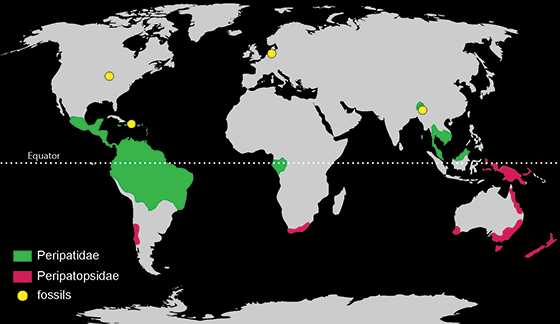Geographical distribution of Onychophora

The onychophoran species are classified in two major subgroups, the Peripatidae and Peripatopsidae, which most likely diverged prior to the breakup of Gondwana over 175 million years ago [1]. Representatives of the Peripatidae are restricted to the Neotropics, the Antilles, West Africa and areas of South-East Asia, including Singapore, Malaysia, Thailand, Indonesia and Vietnam [2, 3]. The species of the Peripatopsidae show a classic Gondwanan distribution and occur in Australia, New Guinea, Chile, South Africa and New Zealand [1, 4, 5]. The oldest putative onychophoran fossil, ✝Helenodora inopinata, occurred in the Late Carboniferous and was found in the Middle Pennsylvanian Francis Creek Shale in Illinois [6, 7]. Additional fossils were reported from the Dominican, Baltic and Myanmar ambers [8, 9].
References
1. Allwood et al. (2010) J. Biogeogr. 37:669–681.
2. Oliveira et al. (2012) ZooKeys 211:1–70.
3. Oliveira et al. (2013) Zool. Anz. 252: 495–510.
4. Reid (1996) Invertebr. Taxon. 10:663–936.
5. Mayer (2007) Zootaxa 1440:21–37.
6. Thompson & Jones (1980) J. Paleontol. 54:588–596.
7. Haug et al. (2012) Curr. Biol. 22:1673–1675.
8. Poinar (2000) Invertebr. Biol. 119:104–109.
9. Grimaldi et al. (2002) Am. Mus. Novit. 3361:3–72.
